Various injuries to the foot (fractures, dislocations, contusions) can promote the development of Morton's neuroma through direct nerve damage, hematoma compression or the development of post-traumatic transverse flatfoot. Other triggers include chronic foot infections, synovitis or tendonitis of the foot, obliterating atherosclerosis or obliterating arteritis of the lower limbs, and the presence of a metatarsal fatatom.
- causes
- Symptoms of thickening of the toe nerve
- Clinical picture of Morton's neuroma
- Treatment of Morton's neuroma
- metatarsalgia of the foot
- Causes of metatarsalgia in the foot:
- Symptoms of Morton's Neuroma
- Diagnosis of Morton's neuroma
- Conservative treatment of metatarsalgia
- Surgical treatment of metatarsalgia (surgery)
- Surgery for hallux valgus deformity and hammer toe
- Conservative treatment of Morton's metatarsus neuromalgia (neuroma)
- Surgical removal - excision of the neuroma
- Treatment of interdigital neuralgia
- Main Points
- symptoms
- How is Taylor's Deformity Diagnosed?
- Symptoms of Morton's Neuroma
- surgical treatment
- video overview
causes
A heavy load on the legs provokes the onset of the inflammatory process. And if a person has another foot pathology (flatfoot, joint disease), then the likelihood of metatarsalgia increases several times.
- Obesity;
- genetic predisposition;
- Tight shoes and constant wearing of high-heeled shoes;
- All forms of spinal curvature;
- Sports that put stress on the lower part of the foot.
Accompanying factors include joint diseases and circulatory disorders.
Symptoms of thickening of the toe nerve
In the early stages, the neuroma can only be felt when walking in tight, constricting shoes, and sufferers feel relieved when they remove them. In the later stages, the pain also occurs when walking barefoot. The pain is progressive.
- numbness in the toe area;
- A foreign body sensation when squeezing;
- A burning sensation in the area where the nerve is located;
- pain syndrome in the fingertips;
- inability to walk.
Clinical picture of Morton's neuroma
The patient usually complains of a burning pain on the plantar side of the metatarsal heads that is neuritic and radiates to the toes. It may be accompanied by paresthesia and numbness. The most common location is between the 2nd and 3rd metatarsal bones. The pain is usually described as stabbing, sharp and 'like walking on stones'.
At the start appears initially only when walking or standing, later also at rest. The patient feels relief when removing shoes and massaging the foot, which relieves pressure between the heads of the metatarsal bones. After these sudden attacks, the pain can last for several days. On examination, the foot appears normal, but palpation can detect a small area of extreme pain in interdigital space III. In advanced cases, crepitation can be noted and a small nodule can be felt in the interdigital space.

pressure between heads of the metatarsal bones Pressure between the heads of the metatarsal bones causes pain, while metatarsalgia of other etiologies focuses on the heads, which helps in differential diagnosis. Compression of all the metatarsal heads together also causes pain in the neuroma. When the toes are hyperextended at the metatarsophalangeal joints, the nerve bends over the metatarsal transverse ligament and causes throbbing pain in the affected toes.
This state should be distinguished from a foreign body, an epithelial cyst, and traumatic bursitis (synovitis).
Treatment of Morton's neuroma
Injections of steroid preparations and lidocaine provide only temporary relief, so surgical removal of the neuroma is the mainstay of treatment and provides long-term relief.
No treatment can be considered complete. description of Forefoot disease associated with pain cannot be fully described without addressing stress fractures of the metatarsal bones, known as march foot fractures. These are covered in the article on foot bone fractures. The patient's history mentions prolonged 'marching' or walking without prior trauma. On examination, the patient feels pain in the middle diaphysis of the third metatarsal, which is most commonly affected.
The pain increases when bending or stretching the toe and subsides at rest while reappearing with exertion. Initial x-rays are negative, but at 2 weeks there is bone marrow in the middle diaphysis. Treatment is symptomatic. In mild cases, walking on crutches is allowed, but if the pain is severe and the patient's occupation requires prolonged standing or walking, a plaster splint should be applied for 3-4 weeks.
Publisher: Iskander Milewski. Release update date: 3/18/2021
The information contained on this website requires consultation with your doctor and is not a substitute for a direct discussion with your doctor.
Please refer to the User Agreement for further details.
metatarsalgia of the foot
Metatarsalgia is pain in the middle of the foot (metatarsus) of the foot, after a short period of time, patients return to their normal lifestyle, only without pain.
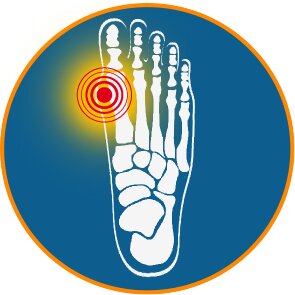
metatarsalgia of the foot – Metatarsalgia is pain in the metatarsal bones of the foot. Metatarsalgia can be mechanical or neurogenic.
Mechanical metatarsalgia is usually caused by an overload of the small metatarsal rays (hallux valgus, hallux rigidus and other foot diseases) or can be caused by anatomical peculiarities of the tarsal bones (long metatarsal bones, Freiberg's disease). A patient with metatarsalgia complains of discomfort in the area of the sole of the foot. This is a fairly common complaint. Pain is most common under the second, third, and fourth toes, less often under the big toe. Metatarsalgia affects walking and causes constant discomfort in the forefoot.
Causes of metatarsalgia in the foot:
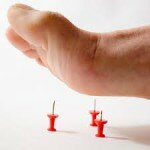
- damage to the interdigital nerves,
- lesions in the metatarsophalangeal joints of the 2nd to 5th toe,
- hallux regidus,
- muscle fatigue
- aseptic necrosis,
- frequent foot injuries,
- poor blood circulation in the feet,
- neuroma,
- synovitis,
- overweight,
- tight shoes,
- augmentation of the metatarsal head,
- arthritis or other osteoarthritis,
- systemic diseases such as diabetes that can cause neuropathic foot pain
- aging, as the fatty layer of the foot thins or atrophies with age,
- Sports in which the arch of the foot is subjected to excessive impact loading (e.g. jogging).
As previously mentioned, the main symptom of metatarsalgia is arch pain, which is most noticeable when walking or exercising. Because the foot supports the core during all activities, chronic arch pain impairs the ability to perform even the simplest activities. Discomfort when wearing shoes and socks.
Symptoms of Morton's Neuroma
The most characteristic pain occurs in the distal parts of the foot, more often in the 3-4 toe. The pain is burning and may be accompanied by a feeling of pressure in the toes. In some cases, patients complain of discomfort and the feeling of having a foreign object in the shoe. At the onset of Morton's neuroma, pain syndrome is closely associated with wearing shoes. Patients notice significant relief when shoes are removed. Over time, symptoms may subside and then reappear. An exacerbation is more often triggered by wearing tight shoes.
The progression of Morton's neuroma leads to a change in pain syndrome. The pain becomes constant, increases when wearing shoes and does not subside when shoes are removed, but only decreases. Numbness in the toes occurs. The initial bouts of pain contribute to patients only presenting to the doctor when the neuroblastoma is already in an advanced stage and conservative treatments have proven ineffective.
Diagnosis of Morton's neuroma
Patients with Morton's neuroma may see a neurologist, orthopedist, trauma surgeon, or podiatrist. The diagnosis can be made based on the clinical findings. The pathognomonic sign is a positive frontal plane compression test of the foot, characterized by an increase in pain and its radiating to the toes supplied by the affected toe nerve.
X-rays of the foot are used to confirm the diagnosis and show the presence of medial longitudinal flatfoot in most patients. However, X-rays and CT scans of the foot do not show the neurinoma. On magnetic resonance imaging, Morton's neurinoma can be seen as an indistinct area with increased signal intensity. However, visualization of the neurinoma by MRI is difficult and can lead to false-negative results. The best diagnostic method is ultrasonography of the suspected neurinoma area. Also, instrumental examination can exclude traumatic lesions, tumors (chondroma, ossificans, lipomas), hemangiomas, and distinguish Morton's disease from arthritis of the foot and deforming osteoarthritis.
Conservative treatment of metatarsalgia
In many cases, metatarsalgia can be effectively treated with conservative therapy. Their type directly depends on the type of disease diagnosed. Therefore, some patients may be prescribed complex drug therapy, others physical therapy and exercise therapy, and still others just need orthopedic devices.
However, conservative treatment is only effective if patients eliminate recurrent forefoot overload. This can be achieved by changing from uncomfortable, tight footwear, especially high heels, to more practical and orthopedically correct footwear. However, many patients, especially women, loathe the idea of having to wear orthopedic footwear. That's because many people find orthopedic shoes gross and unattractive. In fact, there are now many beautiful and shapely models for all occasions that prevent overloading of the forefoot and thus the occurrence of pain and the progression of existing complaints.
Orthopedic shoes have a moderately stiff sole, a rounded, moderately wide nose, often a comfortable, wide heel, and a high, well-fitting footbed.

It is also important to normalize body weight, which is especially important in overweight patients. Since metatarsalgia prevents patients from significantly increasing their physical activity, a visit to a nutritionist may be recommended. The doctor will draw up an optimal nutrition plan, explain the basic principles of food selection and combination, calculate portion sizes, etc. At the same time, such a diet will be rational and balanced. It will provide the body with all the necessary substances and contribute to gradual weight loss. However, all diets, especially mono-diets, are dangerous and give only temporary results. Therefore, they should be abandoned once and for all.
Surgical treatment of metatarsalgia (surgery)
In some situations, patients may be offered surgery immediately, e.g. B. in the following cases

- a grade 3-4 valgus deformity of the first toe;
- hammer toe deformity;
- Morton's neuroma;
- pronounced flat feet;
- severe osteoarthritis of the metatarsophalangeal joint;
- relative extension of 2-3 metatarsal bones;
- Excessive tightening of the calf muscles;
- Failure of conservative therapy after 3-4 months of treatment.
Currently, there are multiple surgical tactics for each type of condition that causes metatarsalgia. In any case, the orthopedist will choose the best surgical technique to achieve the best result.
Modern orthopedic surgery is very safe, especially when performed by a highly qualified, experienced orthopedist. This minimizes the likelihood of classic postoperative complications such as infections, nerve injuries, venous thrombosis and thromboembolism.
Surgery for hallux valgus deformity and hammer toe
Depending on the degree of deformation, the severity of the degenerative changes in the 1st metatarsophalangeal joint, the shape and size of the metatarsal bones, the orthopedic surgeon determines the optimal surgical tactics. This can be soft tissue surgery, indicated in the early stages of the lesions, or a more serious procedure that directly affects the bony structures and joint. The latter intervention is the most common, since metatarsalgia usually occurs when the pathology reaches stage II or III. If hallux valgus is accompanied by a nodule on the lateral surface of the foot, this too is removed as part of major reconstructive surgery.
Conservative treatment of Morton's metatarsus neuromalgia (neuroma)
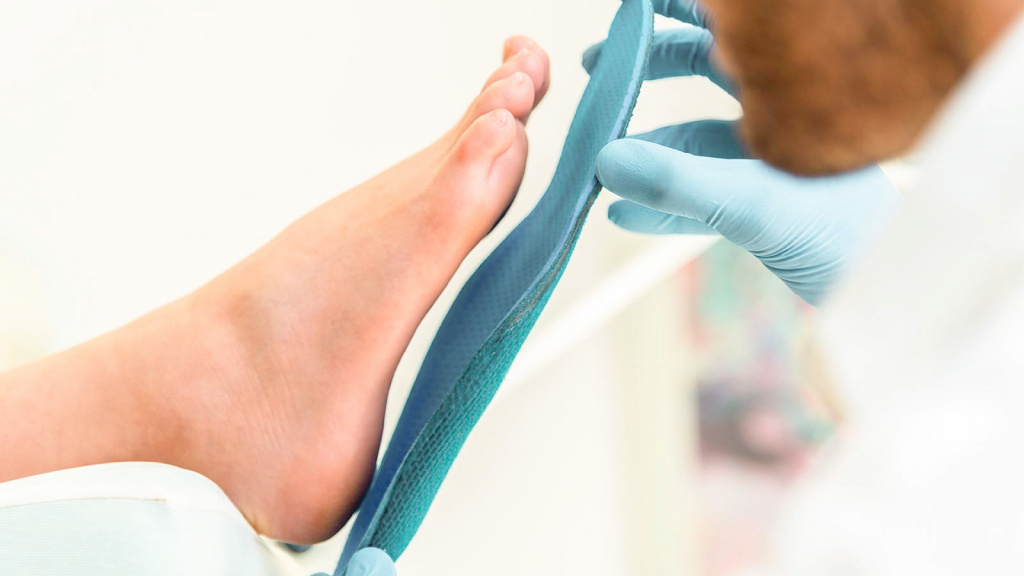
The treatment of Morton's metatarsal neuromalgia on the soles of the feet is individually tailored to the patient - taking into account the cause of the disease and the severity of the symptoms. In the initial period, patients are recommended conservative treatment, which consists of the following measures:
- Relief for the feet - no tight shoes in favor of comfortable or orthopedic shoes with low heels
- Use of insoles and metatarsal elevators – orthotics placed under the ball of the foot and secured to the toes with rubber bands or silicone rings to spread the metatarsal bones and create an anatomically correct curvature of the foot
- Wearing shoes with heel support.
All of these methods have one goal: to reduce the pressure on the damaged nerve trunk. As a result, the further progression of the disease is stopped and the pain syndrome is reduced.
Even more effective is the constant wearing of pads that are specially made for the patient. This solution will:
- to reduce the load on the forefoot and normalize the transverse arch;
- reduce the pressure of the bones and ligaments on the altered nerve trunk;
- Prevention or elimination of soft tissue inflammation, including nerve involvement;
- restore the anatomy of the foot to improve gait and bring it closer to normal.
Drugs used to treat Morton's neuroma do not have a clear therapeutic effect. Patients may be prescribed multi-component compresses, NSAIDs, ointments or gels, but these do not solve the problem. Drug treatment improves the condition, but does not eliminate compression of the nerve.
Physiotherapeutic treatments also only treat the symptoms and the severity of the disease. They are only moderately effective:
Surgical removal - excision of the neuroma

Let's take a look at what the surgical treatment of Morton's neuroma of the foot looks like. The current state of orthopedics enables effective and rapid removal of swellings at any stage of the neuroma.
The thickened nerve is removed under local anesthesia. The orthopaedist decides individually whether the nerve should be accessed from the back of the foot or from the sole side. An incision is then made in the soft tissue to visualize the nerve, and the thickened portion of the nerve is excised. The tissue is then sewn up and covered with a sterile bandage.
The entire operation to remove the neuroma takes no more than 20 minutes. A recurrence of the disease is excluded. The function of the foot and the sensitivity of the toes are fully restored. Just 2 weeks after the operation, the patients are fully fit for everyday life again, and 1.5 months later they can do all kinds of sports without any risk.
As the experience of practicing surgeons shows, patients are more anxious and look for information on how to cure Morton's neuroma on their own than for expert advice and effective treatment. Surgical techniques have now improved, which allows you to get rid of the disease quickly and with a guarantee of quality.
Treatment of interdigital neuralgia
emerging neuralgia With appropriate footwear and insoles or the administration of a local anesthetic, they quickly disappear. Using an insole placed proximal to the head of the metatarsal affected by neuralgia may also help relieve symptoms.
For neuromas Periarticular infiltration with long-acting glucocorticoids in combination with local anesthetics is required, which may need to be repeated several times. The medication is injected into the fissure at the metatarsophalangeal joint and the needle is inserted at a 45° angle to the foot (see 'Inserting the needle at the metatarsophalangeal joint'). Recommendations for using corticosteroid injections Using glucocorticoid injections ). Treating the neuroma with orthotics, rest, cold compresses, and properly fitted footwear often relieves symptoms. Nerve ablation techniques, including injecting 20% % ethanol with a local anesthetic directly into the nerve under ultrasound guidance or cryogenic freezing of the nerve, help relieve symptoms. When other treatments fail, the neuroblastoma is surgically removed, often resulting in complete resolution of the pain. Other neuroblastomas (stump neuroblastoma or amputational neuroblastoma) can also occur at the site of nerve transection and may require additional surgery.
Main Points
Tarsal pain can be caused by irritation or slight thickening of the interdigital nerves.
Initial mild pain from wearing tight shoes may worsen and progress to stabbing pain, sometimes with paresthesia and/or a foreign body sensation.
Diagnosis can be made by the clinical appearance, including pain, and reproduction of symptoms by palpation between the toes.
Treatment consists of changing shoes, prescribing injections of local anesthetic and sometimes glucocorticoid injections, using nerve ablation technology, or performing surgery.
Copyright © 2023 Merck & Co, Inc, Rahway, NJ, USA and its subsidiaries. All rights reserved.
symptoms
Taylor's foot is not just a cosmetic defect in the form of a 'bulge' at the little finger joint. Significant discomfort also occurs, accompanied by the following symptoms
- Pain when walking and running. They are unbearable and force you to limit your physical activities;
- At the end of the day, moderate pain occurs with prolonged walking in tight shoes;
- enlargement of the foot, which makes it difficult to choose new footwear;
- calluses and corns in the little toe area;
- swelling, redness of the toe due to overuse;
- Abrasions, wounds on the lateral surface of the foot.
The procedure lasts up to 20 minutes and no rehabilitation is required. We have a day clinic where we will solve your problem today. Please request a free consultation with our medical coordinator.
How is Taylor's Deformity Diagnosed?
An orthopedist diagnoses and treats this condition. The doctor examines the foot, looking for discomfort, the presence of a little toe protrusion, the condition of the arch of the foot, and skin changes.
Additional tests can help confirm the diagnosis, including:
- X-rays of the foot in straight and lateral projection to assess the severity of the little toe deformity;
- Podometry and plantography, methods necessary for the manufacture of customized insoles.
Symptoms of Morton's Neuroma
Morton's disease presents with acute pain (burning) in the 3rd and 4th toes. The pain worsens when the hands squeeze the foot at the base of the 3.4 toes (when a transverse arch forms). Most patients experience numbness in their toes and foot.
In some cases, a cracking sound can be felt when palpating. The disease goes through phases of exacerbation and remission: the pain increases when wearing tight shoes, when standing or walking for a long time.
The pain decreases with rest, wearing comfortable, wide shoes, and massaging the toes and feet. Over time, the pain becomes constant, regardless of footwear, and does not subside even after rest. Conservative treatment does not alleviate the symptoms.
surgical treatment
Surgical intervention to remove the area of peroneal fibrosis is indicated when conservative management fails. Under local anesthesia, the affected area of the nerve is excised, sometimes leaving numbness around the finger.
Other surgical approaches are based on decompression of the nerve through a minimally invasive osteotomy of the distal metatarsal bones3,4. Cutting the interdigital ligament is not a radical surgical treatment. After the nerve has been removed, the patient can put full weight on the operated foot the very next day. In all cases, wearing wide, soft shoes is recommended.
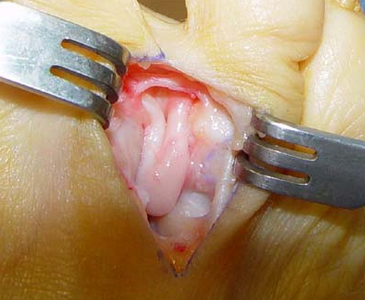 | 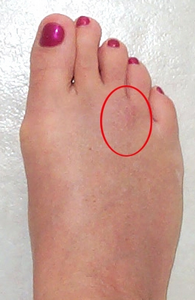 |
The success rate of the operation is very high. According to literature and our own experience, the success rate of surgical treatment is up to 100 %.
Treatment with folk remedies is ineffective, self-treatment can aggravate the condition.
Don't waste your time and money! Don't put your health at risk!
At the first sign of illness, consult a qualified orthopedist. In our clinic we will help you to quickly get rid of your orthopedic problem.
video overview
Read more:- metatarsal bones.
- Treatment of metatarsalgia of the foot.
- Morton's Neuroma Ointment.
- Morton shoe inserts.
- heel nerve.
- hindfoot.
- Metatarsal tarsal bones.
- The tarsal bone hurts from above - what to do?.
